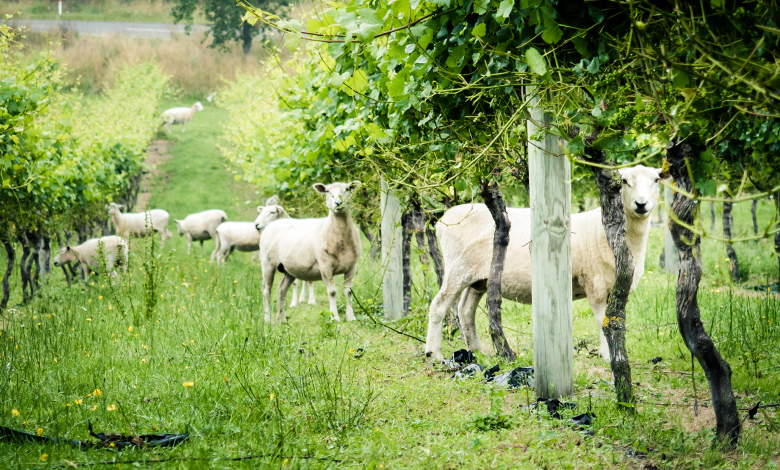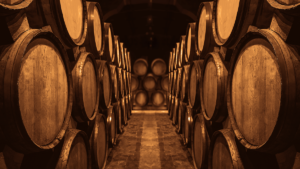
‘Biodynamic viticulture’ sounds a bit science-heavy, that much we can admit. But more than a technical bit of jargon to label natural-leaning, new-wave wines, biodynamics refers to a philosophy dating back to the nineteenth century; an approach to agriculture aligning the ethereal mysteries of the cosmos with the organic material of the earth and its produce. Some devote their lives to it. Others decry the method, likening it to a practice that borders on the occult. Either way, we’re seeing more and more of it about, so it’s worth understanding what a biodynamic label means for the wine in your glass.
What are ‘biodynamics’?
To understand biodynamics, we can begin with a more familiar concept: the organic movement. A reaction against large-scale, industrial methods, organic agriculture bans the use of chemical pesticides and herbicides. For some, a heightened concern for the livelihood of our land and our own health has led to more interest in the origins of what we consume. A Sunday morning spent weaving through the sensory carnival of a farmers’ market outshines the squeaky aisles of Lidl for those lucky enough to have one nearby, and this eco-conscious, producer-focused way of shopping has trickled down into the world of wine, too. Organic wines are made without the use of chemicals in the vineyard, such as herbicides to kill weeds, chemical fertilisers for the soil, or insecticides to repel destructive bugs.
Biodynamic methods take things to another level, from a practical concern about avoiding artificial additives to a more holistic kind of agriculture. This approach sees the farm or vineyard and its surrounding land as a whole living eco-system to be kept in balance. In the world of wine growing, this means taking into account questions of biodiversity, regeneration, responsibility, and vitality in the vineyard and beyond. It’s about looking at the bigger picture.
What does biodynamics mean for the vineyard?
Intrigued by mentions of the lunar calendar, violins in the vineyard, and unlikely advice from one vintner to ‘never uncork [their] wine in a storm’, I was curious to find out what really goes on to treat the sacred ground of a biodynamic vineyard.
From what I can tell, the biodynamic movement has had a bit of a makeover, at least when it comes to its official label. Sadly enough for my search for the weird and wonderful, there was no mention of the moon, the cosmos, or mysterious midnight rituals (and I might even have invented that last one). Instead, much of the emphasis is actually on soil life, regenerative agriculture, and carbon sequestration. I looked into the specific criteria detailed by Demeter, the main body in charge of certifying producers in biodynamics. My hope for a simple list of tick-boxes was a naïve one, and the extensive table of mind-boggling chemical restrictions and viticultural methods was a bit beyond me. The question seemed simple, though – what does a biodynamic wine grower do in their vineyard that’s so different? – so I pushed on and found three key methods central to the biodynamic vineyard:
- Preparations. Compost enhanced with medicinal herbs like yarrow, chamomile, dandelion, and valerian (among others) is used to enrich soil life. It would appear that the natural additives strengthen the compost, increasing its capacity to give back to the earth. Another preparation used is called Horn Silica, which involves packing finely ground quartz into a cow horn and is associated with transferring above-ground energies into the soil (okay, so there is some weird and wonderful stuff going on). Similarly, Horn Manure is buried in the vineyard for its so-called ‘grounding’ properties (although what could be more ‘grounding’ than a vine already growing in…the ground is a bit lost on me).
- Physical methods. Human efforts are always prioritised over technological and chemical solutions. This way, the craft is in harmony with the environment, helping to foster more direct interaction between humankind and nature.
- Diversity. All kinds of organic life is encouraged in the biodynamic vineyard. Biodiversity is good for the health and resilience of plants, and vines are no exception. Animals are sometimes allowed to graze on the soil, too, a physical process that enriches the soil.
Of course, wine growers have varying opinions as to what is best for their vines, and some will go much further in their methods, following the cyclical rhythms of the earth and the cosmos as part of their preparation. This kind of method doesn’t seem to be mentioned in official guidelines (again referring to Demeter), but then would we expect it to be? Approaches that lean into ideas of energy and ritual have their roots in belief systems dating back thousands of years, predating certification systems by a long way. The importance of such methods arguably lies not so much in their efficacy but in their cultural significance; the people committed to them and the traditions they perpetuate.
What does biodynamics mean for the producer?
Like Michelangelo ‘revealing’ his sculptures from the stone surrounding them, a biodynamic vintner ‘does not make wine, they accompany it’. Some of the ideas that keep cropping up include community, tradition, healing the planet, and so-called ‘spirit of place’, always keeping in mind the overall goal of achieving a kind of natural harmony.
This all sounds very poetic, and perhaps a bit vague, but when we get down to the nitty gritty of it, converting to biodynamics is hard graft. It takes at least three years to gain certification, and that’s if the wine estate is already certified organic (a process that takes at least two years). There’s the manpower involved in making wine without the help of machines or chemicals. There’s the financial cost of making the transition and maintaining high standards thereafter. There’s the mental charge that comes with the risks; what if the yield drops, what if the vines don’t adapt well, what if biodynamic methods are too demanding? There are even wine growers who reject outright the pressures of conversion. Armand Heitz, a Burgundy wine grower with strong convictions about working with nature, doesn’t seek labels for his wine, claiming that admin-heavy certification forces the attention of the vintner away from their land and their vocation[1].
Yet more and more producers are taking on the challenge of biodynamic conversion. Since growing wine has always been more than just a job, it is fitting that many producers have found biodynamics to instil their craft with a new lease of life and meaning. In Bordeaux, a region where more ‘natural’ methods of winemaking have taken longer to find favour, some growers have explained how biodynamics has represented more freedom in their work, not more constraints. Alain Moueix of Château Fonroque and Château Mazeyres has expressed how “biodynamics makes it possible to make more singular wines that speak better of the place, the vintage, the winemaker.”[2]. Interestingly, biodynamic wine no longer has the tree-hugging, hippy reputation it might once have endured, with classic estates like Châteaux Latour, Pontet-Canet, and Climens all seeing benefits in embracing alternative methods. Perhaps only a true cynic, and someone ignorant to the enormous efforts required, would see biodynamics as a marketing ploy pandering to the latest wine bar trends.
What does biodynamics mean for the environment?
Biodynamics has evidently inspired wine producers seeking a connection with the earth, but what do their methods do, exactly, for the planet? As I mentioned earlier, regenerative practices and carbon sequestration are now being emphasised as central elements of the movement. Overall, this is all about the natural power that soil has, and its huge potential to help us out of the climate crisis…if we treat it right. When healthy and thriving, soil can hold enormous amounts of carbon. And even more exciting is the fact that, through plants, the soil can even remove and store carbon dioxide that has been sitting in the atmosphere (this is what carbon sequestration means). This is arguably one of the most hopeful bits of knowledge in the face of the climate crisis, as it demonstrates that damage done via excessive carbon emissions is, in fact, reversible.
By managing a vineyard or entire wine estate using biodynamic methods (including the extra preparations, reduction of ploughing, and removal of chemicals), the humus layer of the soil is allowed to regenerate and grow. Since large amounts of CO2 are bound in this humus layer, this can only be good for a healthy carbon cycle and a gradual removal of the carbon currently causing the planet to heat up. With our attention being drawn more and more to the power of soil, it’s looking like these viticultural methods have a real and positive impact on sustainability.
Of course, there are questions to be asked about the scale of this impact. It’ll take a pretty hefty amount of humus to reduce the toxic effects of carbon emissions, and this is unlikely to be possible solely through changes in viticulture. Plus, it could be argued that for an action to be sustainable, it must be accessible, and the potentially off-putting costs and risks associated with biodynamic conversion suggest it is simply not possible for every wine producer to change their methods. However, it seems that overall this is more than a small step in the right direction. Raising awareness about the fundamental importance of soil nourishment and placing it at the heart of agricultural practices (where possible) is a big part of current climate science and thinking. No single person can solve a problem as huge as this, and let’s be honest, we have to start somewhere.
What does biodynamics mean for the wine in your glass?
The all-important question for wine connoisseurs, though, is this: is biodynamic wine good? Is it any better than conventional wine? It’s all very well burying quartz in a cow horn to dig it up a few months later, but what does any of this have to do with the drink eventually poured into your glass? It’s true that, for a long time, any wine that had been made following ‘unconventional’ methods was held at arm length (or much further) by large sections of the fine wine world. It didn’t have the best reputation.
Now, though, we can safely say that the quality of biodynamic wine, in itself, need not be called into question. From famous estates with established status to hidden-away gems and their artisan-scale wine making, we find biodynamic methods being used at every level, and there’s no doubt that these producers can easily compete with conventional vintners. Are biodynamic wines any better, though?
Well, some would claim that it depends on when you taste the wine. Since certain biodynamic wines are made with processes in line with the lunar cycle, for example, there will be subtle differences in the characteristics that emerge. On a root day (a day when the moon is in the earth signs), a biodynamic wine with a mineral profile might well be more enjoyable[3]. If that’s a bit far-fetched for you (no judgement here), there are also some studies showing that organic and biodynamically-produced wines tend to get higher scores from critics[4].
The jury is out on whether the finished wine tastes better than conventionally produced cuvées, but at the very least, we can say that the wine has been made with utmost care for the vineyard and its surroundings. A biodynamic wine necessarily comes from a grower who has put time, energy, and a lot of thought into their methods and what they mean. Whether it’s eco-conscious questions or cosmic energies you’re interested in, an awful lot goes into making biodynamic wine, a feature that stands out in today’s context of globalised mass production.
In conclusion…
Biodynamic wine has gained a lot of legitimacy in recent years. It remains a minority practice in agriculture at large, and certainly in wine making, but the way it engages with the latest climate science should make us sit up and listen.
Also, arguably, biodynamics doesn’t need to be backed by science to be worth something. If I sound at all sceptical about the methods and beliefs of biodynamic producers, I speak as a curious consumer. As a human being, I understand our timeless penchant for ritual and the desire to imbue our choices and practices with meaning. Surely it’s important for us to know that, if possible, the wines we choose to share and enjoy come from a place of deep thought and true passion.
One winemaker changing their relationship with their vineyard won’t save the world, and none of this is to bash conventional winemaking – which remains the source of many (very many) favourites – but biodynamics shouldn’t remain a mystery for wine enthusiasts. This approach to the vineyard is another window through which we can understand the rich world of wine, its origins, its future direction, and the people dedicating their lives to making it.
You’ll find our full selection of biodynamic wines here, if we’ve managed to intrigue you…
[1] https://www.huffingtonpost.fr/entry/je-suis-vigneron-et-voici-pourquoi-je-ne-souhaite-pas-produire-en-bio-blog_fr_616ee0dce4b005b245c2cac5
[2] https://daily.sevenfifty.com/the-challenges-of-going-organic-and-biodynamic-in-bordeaux/
[3] https://paresbalta.com/en/the-moon-and-the-tasting-of-biodynamic-wines/
[4] https://www.thedrinksbusiness.com/2021/03/study-of-200000-wine-scores-shows-organic-wines-taste-better/



